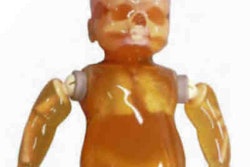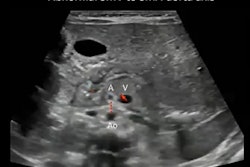
For neonates suspected of having COVID-19 pneumonia, what's the best way to image them given the radiation concerns of CT? Use lung ultrasound, which is noninvasive, convenient, and sensitive, according to a new study out of Wuhan, China.
A research team led by Dr. Wei Li, from the department of medical ultrasonics at Wuhan Children's Hospital, compared 11 neonates born to mothers with COVID-19 with 11 controls. The group found lung ultrasound detected abnormalities in three COVID‐19 neonates with normal radiological performance.
Additionally, a lung ultrasound score provided valuable semiquantitative information on distribution and severity of lung lesions -- information that was missed with conventional x-ray (Pediatric Pulmonology, March 13, 2021).
"The abnormal lung ultrasound findings detected in patients with normal radiography made us believe that lung ultrasound is a sensitive diagnostic tool of neonatal COVID‐19 pneumonia," the authors wrote.
Why use lung ultrasound?
Given the nature of the COVID-19 pandemic, the number of pregnant women with the virus has been on the rise, as previous research has shown that mothers can transmit the virus to their newborns.
Opinions differ on the best modality to use for COVID-19. Chest CT is often employed in diagnosing the disease in adults, but radiation is a concern for neonates. So, Li and colleagues sought to determine the effectiveness of lung ultrasound combined with a lung ultrasound score to semiquantitatively evaluate regional lung aeration and lung lesion distribution.
They retrospectively surveyed all neonates born to mothers with COVID‐19 from January 31 to March 31, 2020, at Wuhan Children's Hospital. They included 11 neonates with confirmed SARS‐CoV‐2 infection and 11 age‐ and sex‐matched controls.
Lung ultrasound was performed in the supine, prone, and decubitus position using a portable ultrasound system (Mindray M9, Mindray Medical) and a linear-array probe with a frequency of 4-12 MHz. Lung aeration loss was estimated using a validated lung ultrasound score. The chest wall was divided into 12 regions (six regions per hemithorax).
The anterior and posterior axillary lines designated practical landmarks that demarcated the anterior, lateral, and posterior areas of both lungs, and delineated the nipple line defining the upper and lower halves. A semiquantitative lung ultrasound score identified four progressive stages of lung aeration loss with an assigned score from 0 to 3. A score of 0 indicated normal aeration, while a score of 3 indicated a complete loss of aeration.
For the COVID‐19 group, the researchers examined a total of 132 regions of the lung, 62.8% of which showed abnormalities detected by lung ultrasound. Compared with controls, COVID‐19 neonates showed sparse or confluent B‐lines (83 regions), disappearing A‐lines (83 regions), abnormal pleural lines (29 regions), and subpleural consolidations (2 regions).
The lung ultrasound score was significantly higher in the COVID‐19 group with 49 regions (37%) presenting as normal, 73 regions (55%) scoring 1, and 10 regions (8%) scoring 2. All lesions were bilateral and involved multiple regions with the majority located in the bilateral inferior and posterior regions.
Additionally, lung ultrasound detected abnormalities in three COVID‐19 neonates with normal radiological performance. The researchers found the lung ultrasound score's intraobserver and interobserver reproducibility to be excellent.
"Asymptomatic patients are not uncommon in the pediatric population, some of whom show radiologic findings of pneumonia," Li and colleagues wrote. "Therefore, it is important for us to be able to recognize the pediatric COVID‐19 patients, using medical imaging modalities."
Using lung ultrasound can reduce chest x-ray usage by 38.8%, the authors noted, and furthermore, employing lung ultrasound in the neonatal intensive care unit roughly halved the number of chest x-rays and significantly decreased the mean radiation dose. Plus, lung ultrasound is more sensitive than chest x‐ray in pediatric patients with COVID‐19, especially in the early stage of the disease and in mild cases, Li and colleagues found.



















